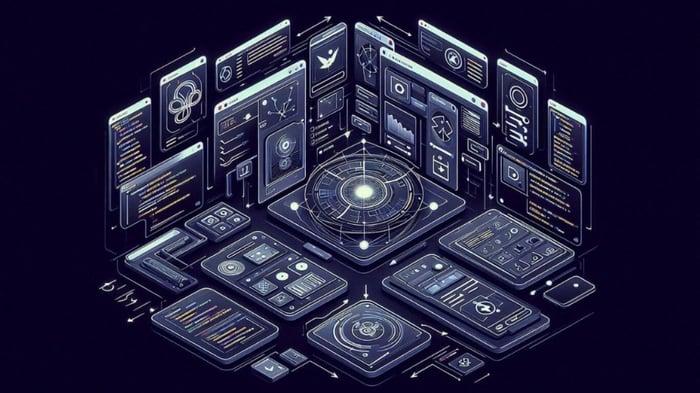

Using AI in Front-End Development: The Future and Scope
Table of Contents
The web development landscape is constantly evolving with the advent of generative artificial intelligence tools. With its ability to learn, adapt, and optimize, AI in frontend development is revolutionizing how front-end developers build and refine web interfaces and user experiences. This technology is no longer a futuristic concept but a present-day reality reshaping the development process. From automating repetitive tasks to enhancing user engagement through personalized experiences, AI's influence on front-end development is vast and growing.
According to Gartner, AI code assistants are predicted to automate 75% of routine tasks by 2028, freeing up valuable time for developers to focus on more complex and creative aspects of their projects . This significant efficiency boost is coupled with the prediction that by 2026, AI will automate 60% of the design effort for new websites and mobile apps, further highlighting its transformative impact on the industry.
As we explore the key applications of AI for frontend development, you'll see how these advancements are not only enhancing productivity but also revolutionizing the user experience. Let's explore the specific ways AI is making a difference in the field.
Key Applications of AI for Frontend Development
Understanding the critical applications of AI for frontend development is essential to appreciate its full potential.
Automated Design and Layout
Automated design and layout involve using AI to generate and adjust web designs quickly based on predefined inputs and user preferences, streamlining the prototyping and iteration phases. CodeParrot.ai is revolutionizing the design process by facilitating rapid prototyping and iterative design. It automatically generates layouts based on user inputs and preferences, enabling designers to create and modify layouts swiftly. This significantly reduces the time needed for manual adjustments and ensures that the design-to-code process is seamless. According to a report by McKinsey, AI-driven design automation can increase productivity by up to 20% in the tech industry. This technology uses machine learning algorithms to generate layouts based on user inputs and preferences, reducing the need for manual adjustments and ensuring a seamless design-to-code workflow.
Real-Time Personalization
Real-time personalization involves using AI to dynamically tailor content and interfaces to individual users, enhancing engagement and retention by providing a customized experience. According to a study by Epsilon, personalized experiences can lead to a 80% increase in customer satisfaction and sales.
AI models, such as Amazon Personalize, tailor content to individual users, enhancing their interaction with the site. This level of customization ensures that users are presented with content that is relevant to them, improving overall satisfaction. By analyzing user interactions and preferences, it adapts the interface and content in real time, providing users with a personalized experience that keeps them engaged and satisfied.
Improving Accessibility and User Experience (UX)
Improving accessibility and UX with AI involves utilizing AI-driven solutions to ensure web content is accessible to all users, including those with disabilities, and enhancing overall user interaction and satisfaction. CodeParrot.ai enhances accessibility and UX through its AI-driven solutions. It offers features that automatically adjust websites to meet accessibility standards, ensuring content is accessible to all users. Tools like Userway and Testim also use AI to make websites more accessible, offering features like real-time translation and voice assistance.
Code Generation and Optimization
Code generation and optimization involve using AI to assist in writing, refining, and optimizing code, making the development process faster and more efficient while ensuring high-quality code. With AI coding assistants like CodeParrot.ai, you can get intelligent code suggestions, auto-completion, and documentation, significantly reducing the time required for coding tasks. AI code generation and optimization ensures that the generated code is clean, efficient, and closely matches the original design, making the development process smoother and more efficient.
Automated Testing and Bug Detection
Automated testing and bug detection use AI to perform various types of testing and identify bugs early in the development cycle, ensuring the final product is of high quality and reliability. Automated testing and bug detection are critical areas where AI for frontend development is making a substantial impact. Automated testing tools like TestCraft, TestProject, TestSigma, and CodeQL leverage AI to perform unit, integration, regression, and performance testing. CodeParrot.ai leverages AI to improve code quality by default by adding testing, documentation, or even more rules in code generation settings. It can automatically detect and report bugs, reducing the need for extensive manual testing and ensuring that the final product is of high quality and reliability.
Challenges and Limitations
Data Privacy and AI's Reliability
Despite its benefits, AI in front-end development poses challenges, such as data privacy concerns and the reliability of AI predictions. Ensuring that AI tools handle user data responsibly is crucial to maintaining trust and compliance with regulations.
Practical Application and Debugging
Implementing AI tools can be challenging in practical applications. Debugging AI-generated code and ensuring it meets project-specific requirements often require additional effort and expertise.
Job Displacement vs. Job Enhancement
The rise of AI also raises concerns about job displacement. However, AI should be viewed as an assistant rather than a replacement. It can enhance developers' capabilities, allowing them to focus on more strategic and creative tasks.
The Future of AI for Front-End Development
While it may seem like AI taking over quite some jobs, it is also creating many jobs in its way. The future of AI for frontend development looks promising. The integration of AI is expected to enhance productivity, streamline workflows, and improve the quality of web applications. Continuous advancements in AI will further solidify its role in development processes.
Role of AI as an Assistant
The sooner we accept the role of AI as a tool to enhance productivity and outputs, the sooner will we able to put it into its greatest feature of serving as an assistant, augmenting developers' capabilities. By automating repetitive tasks and providing intelligent suggestions, AI allows developers to focus on innovation and problem-solving.
Encouragement for Continuous Learning
AI is just another evolution in the development of technology. Therefore, it would constantly benefit Developers must continuously adapt and learn to stay relevant in this evolving landscape. Embracing AI tools and staying updated with the latest advancements will be crucial for future success.
Conclusion
AI has the potential to revolutionize front-end development, making processes more efficient and effective. By balancing the use of AI tools with fundamental coding skills, developers can harness the full potential of AI. As AI continues to evolve, it will undoubtedly play a more significant role in shaping the future of front-end development. By keeping up with these advancements you can stay ahead in the ever-evolving world of web development.
For more insights on integrating AI into your development workflow, check out CodeParrot.ai available today!
Related articles

Development using CodeParrot AI




